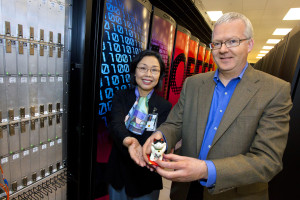50th Anniversary Seminar Series Kicks Off
Join us for a series of seminars celebrating NERSC's legacy and future in scientific supercomputing. » Read More
Boosting Carbon-Negative Building Materials
Locking greenhouse gases into building materials could store them safely for many years. Researchers using NERSC resources are advancing the science behind this idea. » Read More
NERSC Featured at APS
Watch a new video exploring NERSC's mission and impact. It was featured at the American Physical Society's annual meeting. » Read More
Getting a Peek Into Ice Giants
Scientists are using NERSC's Perlmutter supercomputer to study the interior chemistry of ice giant planets like our solar system's Neptune. » Read More
50 Years of NERSC Firsts
Get the highlights from our last half-century of scientific supercomputing. » Read More
National Energy Research Scientific Computing Center
Computing at NERSC
Now Playing
Some Scientific Computing Now in Progress at NERSC
Did You Know?
Lucky Tokens

Yukiko Sekine, Jonathan Carter, and the Hopper system's “lucky cat,” in 2011. (Credit: Roy Kaltschmidt, Berkeley Lab)
NERSC’s Hopper supercomputer contained 153,216 compute cores, 217 terabytes of memory, 2 petabytes of disk storage—and a cat figurine for luck!
Hopper, named in honor of computer scientist Grace Murray Hopper, had a Japanese "lucky cat" figurine stashed in one cabinet. In April 2011, Yukiko Sekine (NERSC's former Energy Department program manager) presented the cat to Jonathan Carter (currently associate lab director for the Computing Sciences Area).
It’s not the first lucky token to stand guard over NERSC’s large, complex, and well-used scientific supercomputers. Other systems – for reasons known only to NERSC staff – have been protected from ill fate by rubber chickens. (»Visit our interactive timeline to learn more about NERSC history.)
NERSC@50

NERSC@50 Seminar Series Kicks off April 15 April 8, 2024

50 Years of NERSC Firsts January 25, 2024











